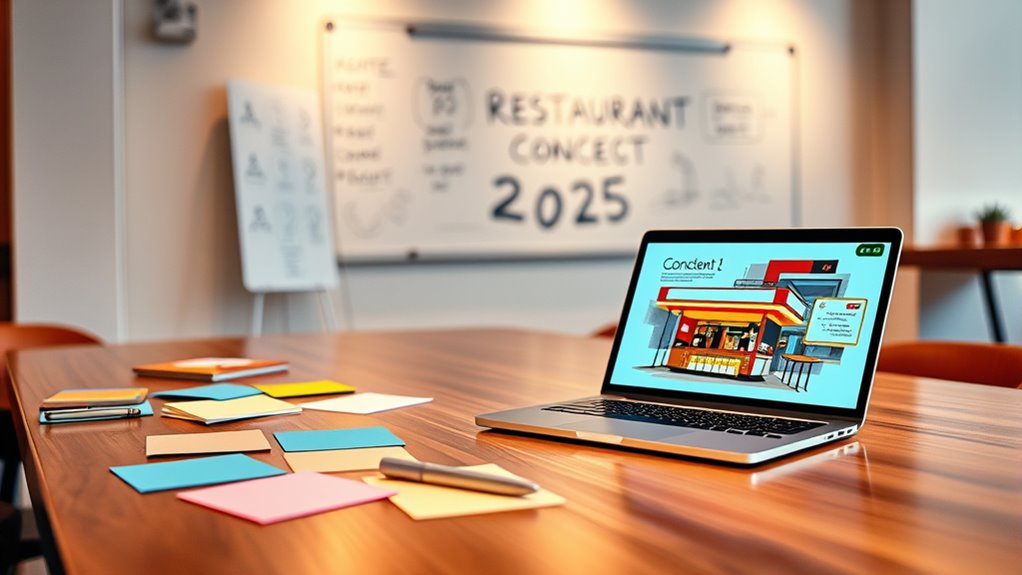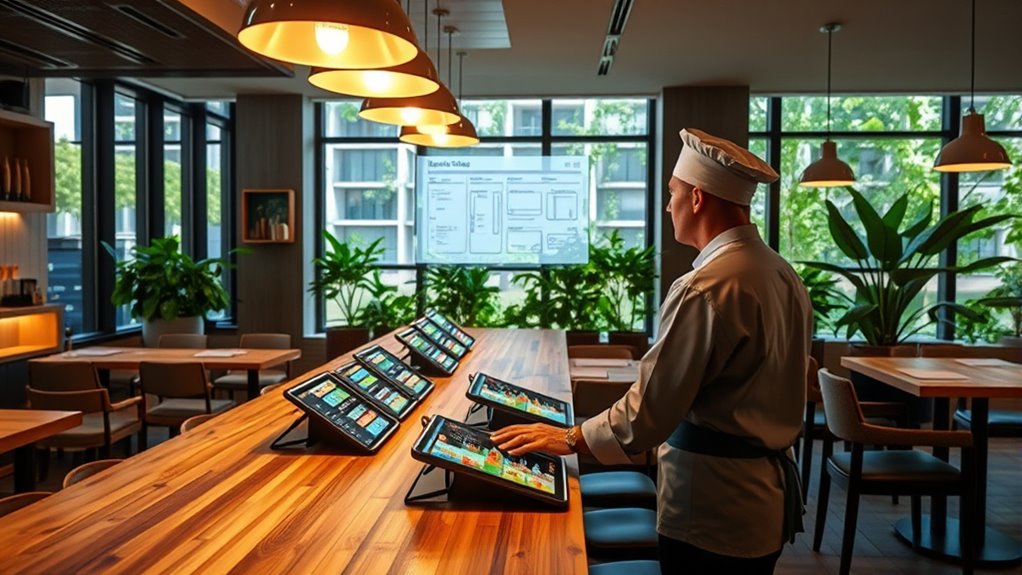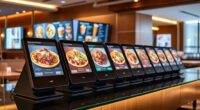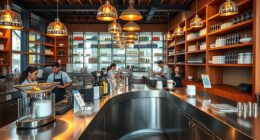To craft a restaurant business plan in 2025, focus on understanding emerging consumer preferences like health, sustainability, and convenience. Incorporate digital tools such as contactless payments, online ordering, and AI-driven reservations to enhance customer experience. Develop a unique concept, competitive menu, and smart pricing strategies while emphasizing eco-friendly operations. Build a strong online presence and marketing plan to attract and retain customers. Keep evolving your plan as industry trends shift—more insights await as you explore further.
Key Takeaways
- Incorporate current market trends, emphasizing health, sustainability, and digital integration to make your plan relevant for 2025.
- Conduct thorough competitor analysis to identify gaps and differentiate your restaurant concept effectively.
- Develop detailed financial projections and budgets, including cash flow, funding sources, and sustainability practices.
- Define clear marketing strategies leveraging social media, geo-targeted ads, and customer engagement tools for digital growth.
- Set SMART goals with measurable KPIs to monitor progress and adapt your plan based on industry shifts and consumer preferences.
Understanding the Market Landscape in 2025

As the restaurant industry evolves in 2025, understanding the current market landscape is crucial for success. You need to stay aware of shifting consumer preferences, which now prioritize health, sustainability, and convenience. Digital ordering and delivery services continue to grow, making online presence more critical than ever. Local competition has increased, so identifying gaps and differentiating your offerings is essential. Tech integrations, such as contactless payments and AI-driven reservations, are becoming standard, impacting customer experience and operational efficiency. Additionally, economic factors and inflation influence pricing strategies and consumer spending habits. Staying informed about industry trends, demographic shifts, and technological innovations enables you to adapt proactively, positioning your restaurant for growth in a competitive, fast-changing environment. Incorporating geothermal heat pumps into restaurant facilities can also enhance sustainability efforts and reduce operational costs, aligning with consumer demand for eco-friendly practices.
Defining Your Restaurant Concept and Unique Selling Proposition

Your restaurant concept sets the tone for everything, so focus on crafting a clear brand identity that resonates with your target audience. Highlight what makes your offerings unique and why customers should choose you over competitors. A strong USP will help you stand out and build lasting customer loyalty. Incorporating a well-defined niche can further differentiate your restaurant in a competitive market.
Crafting Your Brand Identity
Creating a strong brand identity is essential for distinguishing your restaurant in a competitive market. Your brand reflects your restaurant’s personality, values, and promise to customers. Start by defining your core message and visual style—logo, colors, and tone of voice—that align with your concept. Consistency across all touchpoints builds recognition and trust. Use the table below to brainstorm ideas:
| Aspect | Example Ideas |
|---|---|
| Restaurant Theme | Farm-to-table, modern fusion |
| Unique Selling Point | Locally sourced ingredients, live music |
| Visual Identity | Rustic logo, vibrant color palette |
| Brand Voice | Friendly, upscale, eco-conscious |
Clear branding helps attract your target audience and creates a memorable experience. Incorporating elements like vintage decor and rustic furnishings can further reinforce your theme and create a cohesive atmosphere.
Highlighting Unique Offerings
To stand out in a crowded market, defining your restaurant’s concept and unique selling proposition is essential. You need to clearly communicate what makes your restaurant different and why customers should choose you. Focus on your signature dishes, ambiance, or service style that sets you apart. Think about your target audience and what they value most—whether it’s organic ingredients, innovative fusion cuisine, or a themed dining experience. Your unique offerings should resonate with your brand identity and fill a gap in the local market. Highlight these features in your business plan to attract investors and guide your marketing efforts. By emphasizing what makes you special, you’ll create a compelling story that draws customers and builds loyalty. Additionally, understanding color accuracy and visual appeal can help you craft an inviting atmosphere that enhances the dining experience.
Conducting Detailed Competitive Analysis

Conducting a detailed competitive analysis is essential for understanding your restaurant’s position in the market and identifying opportunities for differentiation. Start by researching your direct competitors—note their menus, pricing, service style, and customer reviews. Visit their locations or analyze their online presence to spot strengths and weaknesses. Pay attention to their marketing strategies and customer engagement tactics. This helps you uncover gaps you can fill or areas where you can stand out. Also, monitor industry trends and emerging concepts that could influence your market. Keep track of what successful competitors do well and identify areas where they fall short. For example, exploring Historical Farmhouse Explorations by Region can provide insights into regional themes and storytelling techniques that may differentiate your restaurant. This holistic understanding enables you to craft strategies that leverage your unique strengths and position your restaurant effectively for 2025.
Developing a Menu and Pricing Strategy

You need to carefully choose menu items that appeal to your target audience while maintaining quality and variety. Analyzing costs and setting prices that cover expenses yet remain competitive is essential. Remember, understanding how guests perceive value will help you strike the right balance between affordability and profitability. Incorporating proper pricing strategies can further optimize your menu’s success.
Menu Item Selection
Choosing the right menu items is essential to attracting customers and ensuring profitability. You need to focus on dishes that match your concept, appeal to your target audience, and stand out from competitors. Consider trending ingredients and popular flavors to keep your menu fresh and exciting. Balance your offerings with a mix of quick bites, signature dishes, and dietary options to cater to diverse preferences. Keep in mind the operational aspects, like ingredient availability and prep time, to maintain efficiency. Additionally, regularly reviewing customer feedback and sales data helps refine your selections over time. Incorporating keto-friendly ingredients can also appeal to health-conscious customers and diversify your menu options.
Cost and Price Analysis
Developing a menu and pricing strategy requires a careful analysis of costs to guarantee profitability while appealing to your target customers. First, calculate the food costs for each dish, including ingredients, portion sizes, and waste. Then, factor in labor, overhead, and other operational expenses to determine the total cost per item. Once you know these figures, set prices that cover costs and generate profit, considering your competitors and target market’s willingness to pay. Avoid underpricing, which can hurt margins, or overpricing, which may deter customers. Use a markup approach or a cost-plus pricing model to maintain consistency. Regularly review and adjust your prices based on cost fluctuations and customer feedback, ensuring your menu remains both attractive and financially sustainable.
Value Perceived by Guests
Understanding how guests perceive the value of your menu items is essential for setting prices that attract and retain customers. You need to align your menu offerings with what your target audience finds appealing and worth paying for. Consider factors like ingredient quality, portion size, and presentation, which influence perceived value. To optimize your menu and pricing strategy, focus on these key points:
- Highlight unique or premium ingredients that justify higher prices
- Offer a variety of price points to appeal to different customer segments
- Use menu design and descriptions to emphasize quality and freshness
- Incorporate menu psychology principles to influence customer choices and enhance perceived value
Planning for Technology Integration and Digital Presence

How can your restaurant leverage technology to stand out in a competitive market? Start by establishing a strong digital presence through a user-friendly website and active social media profiles. Invest in online ordering and reservation systems to streamline guest experiences. Utilize data analytics to understand customer preferences and personalize marketing efforts. Implement contactless payments and digital menus to enhance safety and convenience. Consider integrating a loyalty app to encourage repeat visits. Don’t forget to optimize for mobile devices, ensuring your digital channels are accessible everywhere. Regularly update your online content to reflect specials, events, and new menu items. Additionally, understanding emotional support strategies can help your staff better connect with customers and foster a welcoming atmosphere. By embracing these technologies, you’ll attract more customers, improve operational efficiency, and create a modern, engaging experience that sets your restaurant apart.
Crafting a Financial Plan and Funding Strategy

Creating a solid financial plan and securing funding are essential steps to turn your restaurant vision into reality. You need a clear budget that outlines startup costs, operational expenses, and projected revenue to stay on track. Your financial plan should include detailed cash flow forecasts, break-even analysis, and contingency funds for unexpected costs. To attract investors or lenders, prepare compelling financial statements and a persuasive pitch that highlights your restaurant’s potential profitability. Consider diverse funding sources such as loans, angel investors, or crowdfunding. By demonstrating your understanding of costs and revenue streams, you’ll build confidence in your business’s sustainability. Incorporating financial projections and key performance indicators can help you better monitor progress and adjust your strategies accordingly. Develop realistic financial projections and key performance indicators. Identify and approach suitable funding sources early. Create a compelling presentation to attract investors.
Designing a Sustainable and Efficient Operations Model

Designing a sustainable and efficient operations model is essential for long-term success and profitability. You need to optimize workflows, reduce waste, and incorporate eco-friendly practices to stay competitive. Focus on sourcing local, seasonal ingredients to lower costs and support community sustainability. Implement streamlined processes for inventory management and staff scheduling to maximize productivity. Invest in energy-efficient appliances and lighting to cut utility expenses and lessen your environmental impact. Cross-train your team so they can adapt to different roles, enhancing flexibility and reducing staffing gaps. Regularly review your procedures to identify inefficiencies and opportunities for improvement. By building a resilient operations model, you ensure your restaurant remains agile, reduces costs, and aligns with sustainable practices, ultimately strengthening your brand reputation and bottom line.
Building a Marketing and Customer Engagement Plan

To attract and retain customers, you need a strong marketing and engagement plan. Focus on digital marketing strategies, creating a compelling loyalty program, and actively engaging with your audience on social media. These elements will help you build lasting relationships and boost your restaurant’s growth.
Digital Marketing Strategies
Building a strong digital marketing strategy is essential for attracting and retaining customers in today’s competitive restaurant industry. You need to leverage online channels effectively to stand out. Focus on creating engaging content that highlights your unique offerings and atmosphere. Utilize social media platforms to connect directly with your audience and showcase daily specials, behind-the-scenes moments, and customer testimonials. Incorporate targeted advertising to reach local diners and drive traffic to your restaurant. Don’t forget the importance of a user-friendly website optimized for mobile devices, making reservations and menu browsing easy.
- Develop a compelling social media presence
- Use geo-targeted ads to reach nearby customers
- Invest in search engine optimization (SEO) for better visibility
Loyalty Program Development
Creating a loyalty program tailored to your restaurant can substantially boost repeat business and deepen customer relationships. To develop an effective program, start by understanding your customers’ preferences and dining habits. Use data from previous visits and surveys to design rewards that resonate, such as discounts, free menu items, or exclusive access to events. Make sign-up easy, whether through a mobile app or in-person registration, and communicate the benefits clearly. Personalization is key—track customer preferences and offer tailored rewards to increase engagement. Regularly evaluate the program’s performance and adjust rewards to keep customers excited and involved. A well-crafted loyalty program encourages repeat visits, fosters brand loyalty, and turns satisfied diners into ambassadors for your restaurant.
Social Media Engagement
Social media engagement has become a vital component of your restaurant’s marketing and customer relationship strategy. By actively interacting with followers, you build loyalty and attract new customers. To maximize your efforts, focus on creating authentic content that showcases your dishes, staff, and ambiance. Respond promptly to comments and messages to foster trust and community. Use targeted promotions and behind-the-scenes glimpses to keep your audience interested. Consider partnering with local influencers to boost visibility. Remember, consistency is key—posting regularly keeps your restaurant top of mind.
- Share compelling visuals and videos of your menu
- Host interactive contests and giveaways
- Leverage reviews and user-generated content to build credibility
Addressing Regulatory Compliance and Permits

Ensuring compliance with local regulations and obtaining the necessary permits is essential for launching a successful restaurant in 2025. You’ll need to research zoning laws, health department requirements, and licensing procedures specific to your location. Visit local government websites or contact relevant agencies to understand the permits you must secure, such as food service licenses, liquor licenses, and occupancy permits. Staying compliant from the start prevents costly fines or shutdowns later. It’s also wise to track renewal dates and maintain proper documentation. Consulting with legal or regulatory experts can streamline this process and guarantee you meet all current standards. By proactively addressing these requirements, you create a solid foundation for your restaurant’s operations and future growth.
Setting Goals and Metrics for Growth and Adaptability

After securing the necessary permits and meeting regulatory requirements, it’s time to focus on setting clear goals and measurable benchmarks that will guide your restaurant’s growth and adaptability. Define specific targets for revenue, customer satisfaction, and operational efficiency. Use key performance indicators (KPIs) to track progress and identify areas for improvement. Regularly review your metrics to stay agile and respond to industry shifts. Establish short-term milestones to motivate your team and long-term objectives to shape your vision. This focus ensures you’re not only meeting current demands but also positioning your restaurant for future success.
- Set realistic, time-bound goals aligned with your vision
- Track metrics like sales, customer feedback, and staff performance
- Adjust strategies based on data to stay adaptable
Frequently Asked Questions
How Will AI Influence Restaurant Customer Service in 2025?
AI will revolutionize your restaurant customer service by personalizing experiences and streamlining operations. You’ll use AI-powered chatbots to handle reservations and inquiries instantly, freeing staff to focus on genuine guest interactions. Smart data analysis will help you anticipate customer preferences, offering tailored recommendations. Additionally, AI-driven automation ensures faster service and accuracy. Embracing these tools permits you to deliver exceptional, efficient service that keeps customers coming back.
What Emerging Food Trends Should I Consider for My Menu?
You might find that plant-based and sustainable ingredients are gaining popularity, with more diners seeking eco-friendly options. Fermented foods and functional nutrition, like adaptogens and probiotics, are also trending, offering health benefits. Don’t overlook international flavors, especially Asian and Middle Eastern cuisines, which are making a strong impact. Incorporating these trends can set your menu apart and attract health-conscious, adventurous customers enthusiastic for innovative dining experiences.
How Can I Incorporate Sustainability Into Operational Costs?
You can incorporate sustainability into your operational costs by sourcing local, seasonal ingredients, which reduces transportation emissions and supports nearby farmers. Implement energy-efficient appliances and lighting to cut utility bills, and minimize food waste through proper inventory management. Consider composting and recycling programs to lower waste disposal costs. By making these sustainable choices, you save money while demonstrating your commitment to environmental responsibility, appealing to eco-conscious customers.
What Are the Best Practices for Staff Training in a Tech-Driven Restaurant?
You should focus on extensive, ongoing training that emphasizes your tech tools’ proper use. Incorporate hands-on sessions, quick-reference guides, and regular updates to keep staff current. Encourage feedback to identify knowledge gaps, and use role-playing scenarios to build confidence. Leverage digital platforms for flexible learning, ensuring staff stay engaged. Consistent training helps your team master technology, improves efficiency, and enhances customer experience in your restaurant.
How Will Future Delivery and Pickup Options Impact Revenue Models?
Future delivery and pickup options will revolutionize your revenue models more than you can imagine. You’ll see a surge in customer reach, allowing you to serve more people without expanding your physical space. By integrating advanced apps and contactless tech, you’ll streamline operations and reduce costs. This shift means you’ll capture a larger market share, boost sales, and stay ahead of competitors in a rapidly evolving food industry landscape.
Conclusion
As you finalize your restaurant business plan for 2025, remember that understanding the evolving market and embracing innovation are key to success. Will you adapt to changing customer preferences and leverage technology to stand out? By staying flexible, sustainable, and customer-focused, you set yourself up for growth. The future belongs to those who plan thoughtfully—are you ready to turn your vision into a thriving reality?









